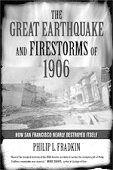
| Back to Table of Contents |  |
Back to Partisan Home |
| Previous Section | Next Section |

"The Great Earthquake and Firestorms of 1906: How San Francisco Nearly Destroyed Itself" Philip L. Fradkin, University of California Press (Berkeley and Los Angeles: 2005). List price $27.50 hardback or $15.95 paperback |
A century after San Francisco's 1906 earthquake and fires, a number of books on the subject have come out. Environmental journalist Philip Fradkin's book was published before Hurricane Katrina, but the parallels between the unnatural responses to natural disasters in 1906 and 2005 are striking.
In 1906, an earthquake caused significant damage throughout coastal central and northern California, but because it was the big city and because of the related fires, we mainly hear about San Francisco. Proportionally, the heaviest damage was in Santa Rosa.
In 2005, Hurricane Katrina caused significant damage along the Gulf Coast, heaviest in Mississippi, but we mainly hear about New Orleans, the big city subsequently flooded by levee failure.
In 1906, official incompetence, a breakdown of communications, and concern with "looting" made a bad situation worse. San Francisco's fire chief died in the earthquake, and the army generally took charge of fire-fighting, blowing up buildings with explosives that often created new fires. Telephones and telegraphs didn't work, so couriers were the main means of communication. Meanwhile, a "shoot to kill" policy against "looters" was enforced by vigilantes, police, the army and the state militia equally against actual looters, people taking needed supplies for themselves and neighbors, and residents taking their own possessions out of their damaged homes.
In 2005, official incompetence, communications breakdowns, and concern with "looting" made a bad situation worse. Federal, state and local officials left the poor without cars out of evacuation plans. Emergency communications broke down when equipment was knocked out by the hurricane or by flooding of generators. As water poured into New Orleans, police, National Guard troops and security contractors stopped trying to evacuate people to maintain order and stop "looting".
In 1906, ordinary people defying authority and low-level officials improvising and going beyond orders saved the few parts of eastern San Francisco that didn't burn. A few blocks on Russian Hill didn't burn, and residents defied orders to leave so they could put out the fires that did approach. The Embarcadero waterfront and a few nearby areas didn't burn because Navy Lieutenant Freeman, who arrived from Mare Island the morning of the earthquake with his destroyer and two tugboats, took charge of the area where it was difficult for General Funston (or city officials) to tell him what to do. His men, volunteer residents and the crews of some ships kept the port and adjacent railyards from burning, allowing refugees to flee and help to arrive later.
In 2005, some New Orleanians took food and water from stores to supply isolated residents and commandeered boats, trucks and buses to evacuate people from flooded homes. Initial reports labeled them "looters." Some military helicopter pilots were punished for rescuing victims from rooftops instead of immediately returning to Florida after delivering supplies to military units.
In 1906, racism and class war didn't take a break. Fradkin quotes the Washington Star, "About the only gratifying feature of the San Francisco horror is that Chinatown has been destroyed. That pestilential community is no more." Local authorities kept Chinese out of the whites' refugee camps and tried unsuccessfully to move Chinatown (the Chinese and their white landlords resisted). Government ceded responsibility and decisions on reconstruction and relief to an unelected "Committee of Fifty" prominent citizens.
In 2005, racism and class war didn't take a break. From the media coverage of the Superdome and Convention Center, to sheriffs whose guns turned away blacks at the bridge to Gretna, we saw how the poor African-American majority in New Orleans was treated. Thousands of tenants were evicted from undamaged housing, and the powerful contemplate converting the city into a gentrified tourist attraction.
A controversial aspect of Fradkin's book is on the post-earthquake "graft prosecution," which he portrays as largely an attack by business-oriented "Progressives" on organized labor. California local elections were then partisan, and in 1901 a "Union Labor Party" was formed in reaction to police scab-herding during a streetcar strike. Their mayoral candidate, Eugene Schmitz, was elected that year in a three-way race, and re-elected in 1903, though the Republicans and Democrats still controlled the Board of Supervisors. In 1905, Schmitz won a majority over a Democratic-Republican fusion ticket, and the Union Labor Party swept all the seats on the Board of Supervisors.
The privately-funded "graft prosecution" began in secret a few months before the earthquake, though some of its leaders had accused Mayor Schmitz and Abe Ruef, the purported boss of a Union Labor Party machine, of corruption during the 1905 campaign. Ruef, a Jewish lawyer, was a mid-level Republican leader in the North Beach area. Fradkin sees Ruef as a scapegoat, noting that Ruef "was not a boss in the conventional sense of the word" but a fixer and high-powered lobbyist, advising the mayor while accepting attorney's fees and paying out some of the proceeds to elected officials "as was not unusual at the time". Of hundreds accused, Ruef was the only alleged grafter to go to prison; everyone else was granted immunity, acquitted or cleared on appeal.
On the other hand, the Union Labor Party wasn't all that pro-worker in its policies, and Ruef continued as a Republican leader while advising Union Labor Party leaders. One of the largest payoffs that Ruef handled after the earthquake was from the United Railroads, the successor to the streetcar companies involved in the 1901 strike that gave birth to the party. I'll reserve my judgment on this, and wait for publication of current research by radical historian Larry Shoup.
--Dave Kadlecek
| Back to Table of Contents |  |
Back to Partisan Home |
| Previous Section | Next Section |